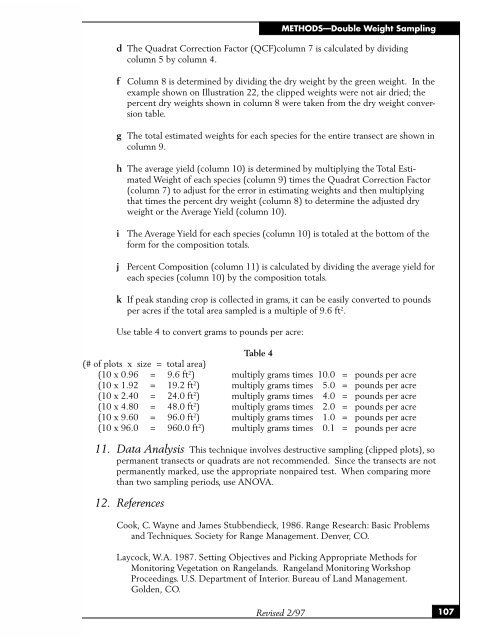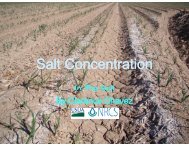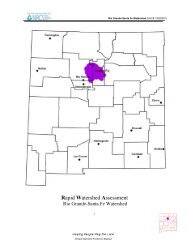SAMPLING VEGETATION ATTRIBUTES - New Mexico NRCS - US ...
SAMPLING VEGETATION ATTRIBUTES - New Mexico NRCS - US ...
SAMPLING VEGETATION ATTRIBUTES - New Mexico NRCS - US ...
Create successful ePaper yourself
Turn your PDF publications into a flip-book with our unique Google optimized e-Paper software.
METHODS—Double Weight Sampling<br />
d The Quadrat Correction Factor (QCF)column 7 is calculated by dividing<br />
column 5 by column 4.<br />
f Column 8 is determined by dividing the dry weight by the green weight. In the<br />
example shown on Illustration 22, the clipped weights were not air dried; the<br />
percent dry weights shown in column 8 were taken from the dry weight conversion<br />
table.<br />
g The total estimated weights for each species for the entire transect are shown in<br />
column 9.<br />
h The average yield (column 10) is determined by multiplying the Total Estimated<br />
Weight of each species (column 9) times the Quadrat Correction Factor<br />
(column 7) to adjust for the error in estimating weights and then multiplying<br />
that times the percent dry weight (column 8) to determine the adjusted dry<br />
weight or the Average Yield (column 10).<br />
i The Average Yield for each species (column 10) is totaled at the bottom of the<br />
form for the composition totals.<br />
j Percent Composition (column 11) is calculated by dividing the average yield for<br />
each species (column 10) by the composition totals.<br />
k If peak standing crop is collected in grams, it can be easily converted to pounds<br />
per acres if the total area sampled is a multiple of 9.6 ft 2 .<br />
Use table 4 to convert grams to pounds per acre:<br />
Table 4<br />
(# of plots x size = total area)<br />
(10 x 0.96 = 9.6 ft2 ) multiply grams times 10.0 = pounds per acre<br />
(10 x 1.92 = 19.2 ft2 ) multiply grams times 5.0 = pounds per acre<br />
(10 x 2.40 = 24.0 ft2 ) multiply grams times 4.0 = pounds per acre<br />
(10 x 4.80 = 48.0 ft2 ) multiply grams times 2.0 = pounds per acre<br />
(10 x 9.60 = 96.0 ft2 ) multiply grams times 1.0 = pounds per acre<br />
(10 x 96.0 = 960.0 ft2 ) multiply grams times 0.1 = pounds per acre<br />
11. Data Analysis This technique involves destructive sampling (clipped plots), so<br />
permanent transects or quadrats are not recommended. Since the transects are not<br />
permanently marked, use the appropriate nonpaired test. When comparing more<br />
than two sampling periods, use ANOVA.<br />
12. References<br />
Cook, C. Wayne and James Stubbendieck, 1986. Range Research: Basic Problems<br />
and Techniques. Society for Range Management. Denver, CO.<br />
Laycock, W.A. 1987. Setting Objectives and Picking Appropriate Methods for<br />
Monitoring Vegetation on Rangelands. Rangeland Monitoring Workshop<br />
Proceedings. U.S. Department of Interior. Bureau of Land Management.<br />
Golden, CO.<br />
Revised 2/97<br />
107




